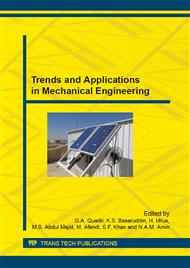p.8
p.13
p.18
p.23
p.28
p.33
p.37
p.43
p.48
Effects of Temperatures on the Compressive Strength of Napier Grass Filler-Filled Unsaturated Polyester Resin
Abstract:
This paper describes the effect of weight contents of fillers on the compression properties of the Napier grass filler-filled polyester resin. Unsaturated polyester resins with 0, 1, 3, 5 wt% Napier fibre based fillers were prepared through manually mixing process in accordance with ASTM D695 for compressive test. The static unaxial compressive tests were conducted using a Shimadzu Universal Testing Machine with a thermostatic chamber at temperatures ranging from room temperature (RT) to the temperature close to its glass transition temperature Tg (RT, 35, 55, 75 °C). The result shows that the elastic modulus and compressive strength of the modified resin were significantly affected by Napier fibre based filler contents and temperatures. It was found that the specimens showed reductions in compressive strength with increases in temperatures.
Info:
Periodical:
Pages:
28-32
Citation:
Online since:
August 2015
Authors:
Price:
Сopyright:
© 2015 Trans Tech Publications Ltd. All Rights Reserved
Share:
Citation:


